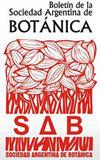本研究的目的是分析在墨西哥恰加斯州和恰加斯州的恰加斯河流域,以及在墨西哥恰加斯州和恰加斯州的恰加斯河流域,以及在墨西哥恰加斯州和恰加斯州的恰加斯河流域,以及在墨西哥恰加斯州和恰加斯州的恰加斯河流域。
IF 0.7
4区 生物学
Q4 PLANT SCIENCES
Boletin De La Sociedad Argentina De Botanica
Pub Date : 2018-04-20
DOI:10.31055/1851.2372.v53.n1.19860
引用次数: 0
摘要
播种密度对阿根廷西北部藜麦品种CICA光合活性的影响。为获取供人类食用的谷物而种植的藜麦作物已开始在海拔2000多米的Calchaquies山谷(阿根廷图库曼)地区推广。藜麦作为一种新型的替代作物,必须对其进行生态生理和农艺研究,以使其得到充分的管理。本研究分析了播种密度对不同光子通量密度(DFFF)下光合响应的影响,计算了最大同化(A max)、光饱和点(PSL)、光补偿点(PCL)、光合效率(O CO2)和暗呼吸(R n)值。提供了净光合同化(n)、气孔导度(g s)、叶片蒸腾(T r)、内部co2浓度(C i)、羧化能力(A n /C i)和株间水分利用效率(EUA i)的相关数据。测定光合色素(叶绿素和类胡萝卜素)和保护色素(305 nm吸光度)。研究表明,气体交换参数与水稻的形态、叶面解剖结构和籽粒产量直接相关,而播种量对其有直接影响。本文章由计算机程序翻译,如有差异,请以英文原文为准。
Efecto de la densidad de siembra sobre la actividad fotosintética en Chenopodium quinoa var. CICA (“quínoa”) en el Noroeste Argentino.
Sowing density effect on photosynthetic activity of Chenopodium quinoa var. CICA (“quinoa”) in the Argentinean Northwest. Quinoa crop to obtain grain for human consumption has begun to spread in the region of Calchaquies Valleys (Tucuman, Argentina) over 2,000 m asl. Because quinoa is a new alternative crop, must be carried out ecophysiological and agronomic studies to get its adequate management. In this study the effect of sowing density on the photosynthetic response against different photon flux densities (DFFF) was analyzed in order to calculate the maximum assimilation (A max ), light saturation point (PSL), light compensation point (PCL), photosynthetic efficiency (O CO2 ) and dark respiration (R n ) values. Data in relation to net photosynthetis assimilacion (A n ), stomatal conductance (g s ), leaf transpiration (T r ), internal CO 2 concentration (C i ), carboxilation capacity (A n /C i ) and intrinsec water use efficiency (EUA i ) are provided. In addition, photosynthetic pigment (chlorophylls and carotenoids) and protective one (absorbance at 305 nm) were measured. This study demonstrates that gas exchange parameters are directly correlated with morphology, foliar anatomy and grains yield and that the sowing density has a direct effect on them.
求助全文
通过发布文献求助,成功后即可免费获取论文全文。
去求助
来源期刊

Boletin De La Sociedad Argentina De Botanica
PLANT SCIENCES-
CiteScore
1.00
自引率
33.30%
发文量
46
审稿时长
>12 weeks
期刊介绍:
Bol. Soc. Argent. Bot. publishes original scientific works from the whole spectrum of Plant Biology (structure, anatomy, development, physiology, cytology, genetics, evolution, ecology, paleobotany, palynology, ethnobotany, etc.) in the diverse vegetable organisms and related groups (mycology, ficology, lichenology, briology, etc.), both in basic and applied aspects.
Taxonomic works (of systematics, phylogeny, monographs, revisions, lectotypifications, nomenclatural acts, descriptions of taxa), phytogeographic and phytosociological works (survey and classification of vegetation at different spatial scales and without restriction of methodological approaches) are considered for publication. Contributions that address complete phytogeographic units or sub-units and those that fill gaps in knowledge of vegetation in little-known territories are especially welcome. Extensions of geographical areas are published only when it comes to new citations for a country. Checklists and lists of annotated plants are not published.
Articles submitted for publication must be original and must not have been submitted to another publisher or previously published (print or electronic format). Submissions of papers already published in another language will not be accepted (autoplagio for translation).
 求助内容:
求助内容: 应助结果提醒方式:
应助结果提醒方式:


